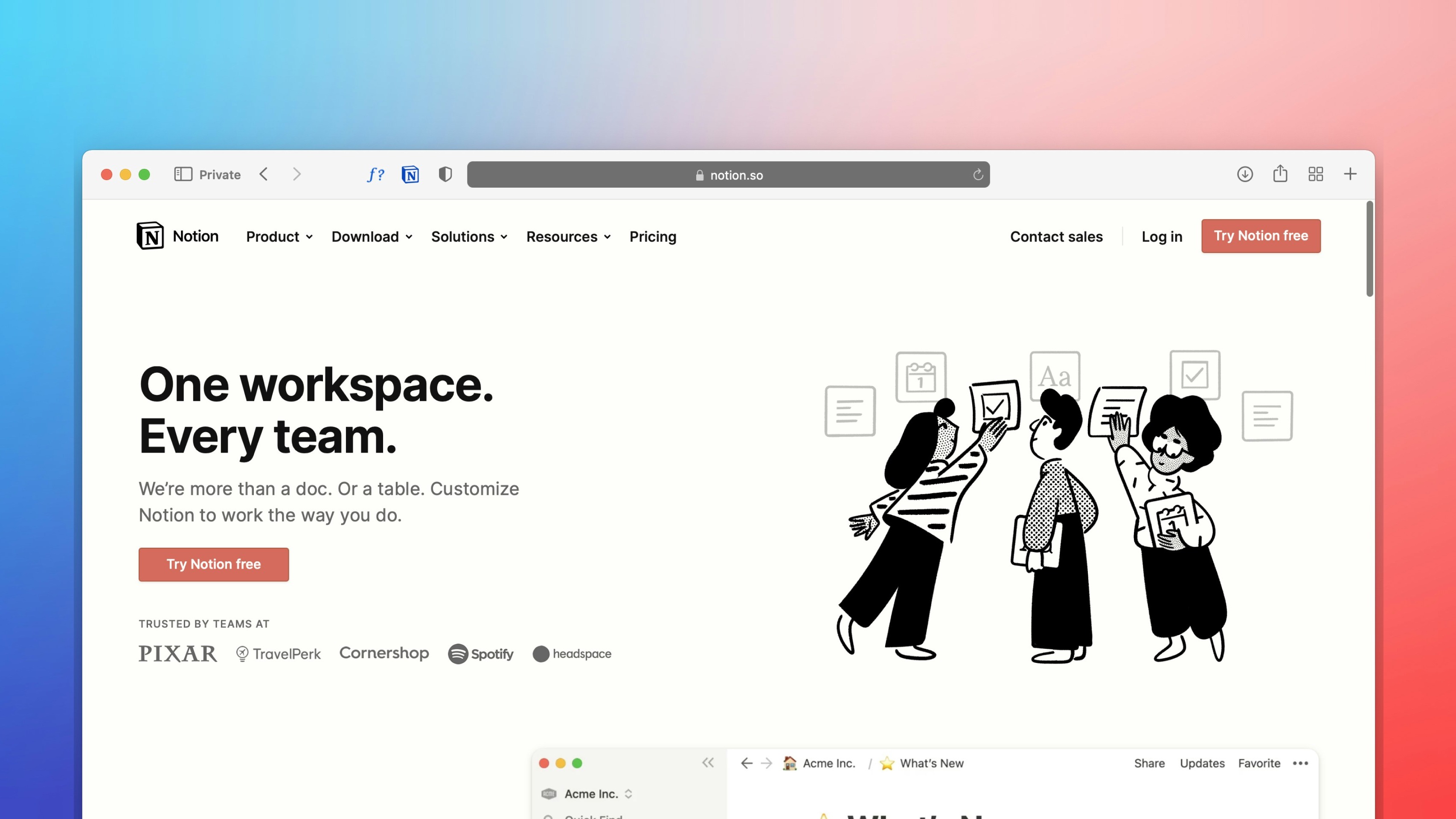 Freelancer tips
Freelancer tips Notion: What It Is, What It’s For, and How to Use It in Your Daily Life
Want to better organize your life and work? Notion can help boost your productivity. Click here to discover what this software is and what it’s used for.



With technological innovation, work models have gradually shifted toward the digital world. In this context, self-employment has been promoted because it offers significant benefits for both companies and workers. Today, I'll tell you what a Freelancer is and everything you need to learn to be a Freelancer in Mexico.
In short, a Freelance worker is an independent contractor. They’re not required to be an employee of a company or to have a long-term employment contract.
Instead, they can arrange short-term work contracts, or even proceed on a per-demand basis, sometimes without a formal contract at all.
This working model is quite productive for professionals, as it gives them the possibility of working in multiple fields, for multiple companies, and on multiple projects simultaneously.
For companies—particularly small and medium-sized businesses—hiring freelancers can be a major advantage that helps lower costs related to:
Taxes
Social security
Pension plans
Among other expenses that the freelancer pays themselves. In fact, freelancers are responsible for funding their own vacations and sick leave.
Yet, far from being detrimental, many people see these arrangements as a plus.
By working independently, professionals can boost their productivity, design their own work schedule, and handle personal projects. Plus, they can operate remotely for clients worldwide.
To really answer “what is freelance?”, it also helps to examine different types of remote workers:
This group includes writers, developers, translators, managers, designers, and consultants.
Here, we see people who’re hired by contractors on a self-employed basis—like cleaners, builders, and other workers without a specialized skillset.
The big difference between these two freelancer types is that the first category typically works online.
Being a freelancer is similar to running your own business, given that you’re in charge of all aspects of your professional activity.
For a better grasp, here are some key considerations:
If you want to operate officially as a freelancer, you must register with SAT (Tax Administration Service). This involves listing yourself as an individual with business activity or under the “Servicios Profesionales” regime. Depending on the option chosen, you’ll have specific tax obligations.
After registering, you must file monthly and yearly returns to cover taxes such as ISR. Because yes, freelancers pay taxes even if they work on platforms like Fiverr.
Maintaining an orderly system of invoices, income, and outflows will ease that process and prevent issues when the fiscal year closes.
Despite not working for a company, you can still protect yourself with health, income, or business insurance. For example, affiliating with IMSS is one way to obtain healthcare and a pension plan. You might also consider private insurance tailored to freelancers.
Having a separate bank account for your freelance jobs is recommended, although not mandatory. Some Mexican banks offer business accounts that keep personal and professional finances apart—making it easier to calculate tax-deductible expenses and track revenue.
Finding clients is crucial. You can start scouting them even before going freelance, ensuring a stable flow of work. Also, their endorsements are key to attracting future projects.
You can use LinkedIn to get freelance work and also to position your personal brand. These are two key aspects of client search.
A written contract protects both you and your client. It should spell out project scope, payment deadlines, and responsibilities on both sides. You can keep it simple; there are plenty of generic online templates you can customize.
As mentioned, working as a freelancer in Mexico has various implications that may be viewed either favorably or unfavorably, depending on your situation.
A freelance worker enjoys the convenience of controlling their own workflow and schedule. But that same freedom entails crucial responsibilities—like paying for your own benefits.
Let’s discuss these advantages and disadvantages in detail.
Not having a signed contract with any company means that the freelancer has control over the projects he/she takes on. This also includes the costs to be charged for their work. This makes the freelancer more cost-effective over time, increasing his or her ability to negotiate with employers. At the same time, he/she has the possibility to generate a higher income.
In addition, as they become more and more proficient in an area and master more and more aspects of it, they are able to provide specialised services. This will help you to greatly increase your freelance income.
Independent work grants huge freedom over daily routines and schedules. For instance, you don’t have to stick to a rigid 8-hour shift; you can arrange your tasks in the time blocks that suit you best. This fosters personal responsibilities at a high level—since your productivity relies completely on you.
By controlling your own schedule, you can work from home while staying on top of household responsibilities. You can plan around personal obligations or family needs more flexibly.
Since you’re not in an office, there’s no mandated dress code or uniform. As an independent pro, you’re free to shape your personal brand in any style you want.
Arguably the biggest plus of being self-employed is enjoying lots of flexibility. You can design your work framework—whether it’s morning or night blocks, or shorter scattered intervals—especially if you need creative bursts at certain times.
You have no signed contract binding a company to fulfill legal obligations for you. Being a freelancer provides tremendous independence, but it also means you’re responsible for paying your own taxes, insurance, retirement savings, vacations, and other benefits. In short, you cover everything that an ordinary worker typically receives from an employer.
Yes, it’s lovely to set your schedule and work from home, but it can be daunting for some—especially extroverts who thrive in a busy social environment. A self-employed person at home might feel lonely if, for instance, they’re living alone and their home is both workspace and personal space.
The awesome freedoms in freelancing include taking days off whenever you want and making time for personal issues—basically working whenever suits you. But that can be a double-edged sword. As a freelancer, you only get paid when you’re actively working.
If something prevents you from doing your job, there’s no one to pay you by default. Employees in traditional roles might continue receiving wages despite an inability to work—whereas a freelancer must rely on their own finances. This can be dangerous if you’re ill or have an accident, especially without a solid financial plan.
Having clarified what freelance means, let’s cover which careers and skills are in high demand—helping you see if yours align with these fields so you can consider becoming a freelancer in Mexico:
1. Web Developer
More and more businesses and companies need to create a website. Or perhaps to modernize the older ones they have.
This makes the product or service in demand and, therefore, a programmer can perfectly work as a freelancer in this sector.
2. Digital Marketing
Marketing and advertising strategies have become increasingly complicated. Expanding the communication channels that every business must have in order to generate sales and connect with their customers. A freelance digital marketing specialist in a specific area can sell their services efficiently.
3. Data Analyst
Data is a key part of the digital revolution. Managed effectively, it can drastically improve a business’s efficiency. This calls for freelance involvement in data analytics.
4. Copywriter, Proofreader, or SEO Specialist
Written content remains a cornerstone of online sales and communications. Freelance copywriters find excellent opportunities serving clients in multiple niches.
5. Virtual Assistant and Sales
SMEs often need more manpower but don’t want to hire permanent staff. A freelance assistant or salesperson can help unclog backlogs while avoiding a full-time hire.
6. Photo and Video
Today’s digital culture is increasingly visual. Hiring a freelance photographer or videographer is more feasible than building an in-house team, so if you’ve got these skills, you’re set.
Now that we’ve explored the meaning of “freelance,” along with its pros, cons, and the in-demand fields, let’s see what’s essential for starting out:
You might think you don’t need strong credentials to freelance, but clients typically want proof of your skills. Diplomas can help, yet a strong portfolio often carries more weight. Nonetheless, you may face fewer formal requirements compared to a typical corporate job.
Without a company to represent you, you’re your own salesperson. That means proactively pitching your services and marketing your talents. You’ll also be setting your own rates—another reason you need good negotiation skills.
Your reputation helps you land new clients—so it’s vital to keep your end of any agreement and do top-notch work, growing a reliable network for steady gigs.
A great way to build trust is to collect and share client testimonials - why? Because it reflects the quality of your work and the positive impact you have had on previous projects.
Apart from enhancing your credibility, it makes it easier for future clients to trust your services.
Notice that most freelance jobs revolve around digital environments, so leverage these tools to broadcast your talent. A blog, video channel, or organic social media presence can all boost your exposure to potential customers.
Yes, defining “freelance” also describes the massive freedom of a boss-free schedule. Yet, a freelancer must cultivate discipline and patience to stay productive—particularly given the independence that marks self-employment.
Before you venture into this type of work, here are some tips to find your first clients:
1. Offer a Base Service—one that’s simple and easy to understand, appealing to as many people as possible.
2. Keep It Simple—craft a profile focusing on the knowledge you already have.
3. Build a Portfolio—demonstrate past work, or if you lack clients, create sample projects, even for free, to prove your capabilities.
4. Develop a Personal Brand—use social media to express your personality and highlight your freelance work in Mexico.
5. Have a Website—so your services can reach the widest audience possible.
6. Seek Referrals—if you don’t yet have paying clients, maybe do free assignments. Let them review or recommend your work, giving you a track record that attracts new customers.
7. Register on Freelance Platforms—which display your work to those specifically searching for your skillset.
Working freelance brings plenty of upsides. You can start right away—even with limited schooling or corporate experience. Opportunities multiply each day through digital channels, referral systems, or websites dedicated to remote jobs, such as Indeed.
Plus, remember that you control your own time, which means you can carefully balance life’s demands. And it’s a way to shape a professional path that aligns with your goals.
Mexican freelancers often become true multi-talents—not only experts in their specific service, but also adept in client interaction and personal branding. Step by step, you can scale up, eventually forming a business around your professional profile.
If learning what “freelance” means has convinced you to embrace this independent work style, here are five concrete suggestions for becoming a top-notch freelancer:
1. Be Disciplined and Organized—both with your projects and the physical environment you work in.
2. Be Completely Honest—never promise more than you can deliver.
3. Build an Attractive Portfolio—and one that resonates with the market or niche you want to target.
4 Specialize in One Field—that’s how you can steadily charge more for your services.
5. Remember Patience—freelancing takes effort. Initially, you might charge lower fees or do freebies to get started, but once you gain experience, you can command higher rates.
Master everything you can—like using infographics or concept maps—and incorporate it all into your marketing.
Don’t neglect strategies for promoting your freelance business to reach a broader audience.
Lastly, we suggest DolarApp as a reliable way to reduce currency exchange costs. It allows you to receive payments in dollars and convert them into local currency at favorable rates.
Having clarified what a freelancer is and what you need to get started, let us guide you on this path. Feel free to learn more on our blog!

The world has borders. Your finances don’t have to.
 Freelancer tips
Freelancer tips Want to better organize your life and work? Notion can help boost your productivity. Click here to discover what this software is and what it’s used for.

 Freelancer tips
Freelancer tips Project chaos? Learn how Trello can help you organize tasks and improve your productivity.

 Freelancer tips
Freelancer tips ClickUp can make any freelancer more productive. Discover what it is, how it works, and the advantages this tool offers you


